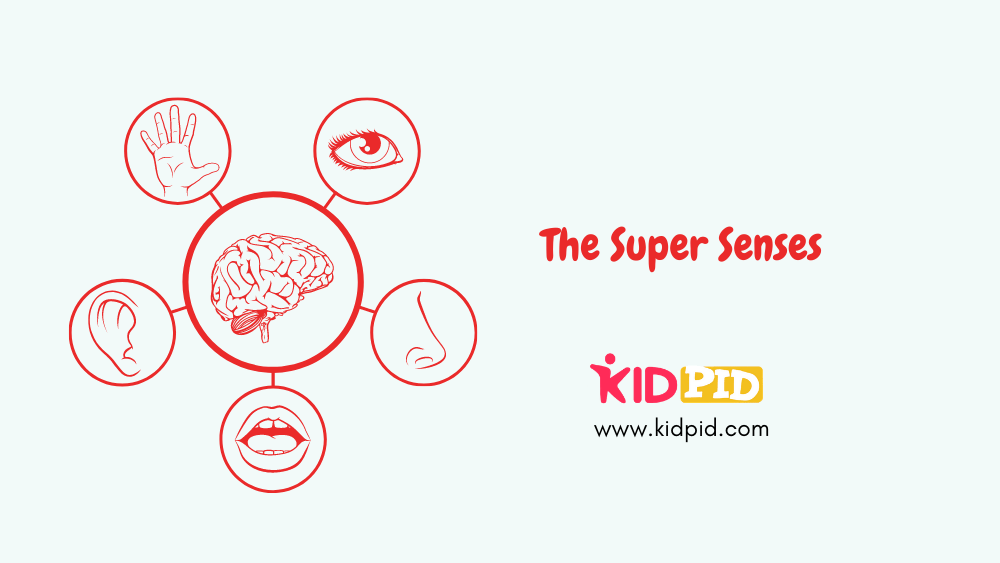The Super Senses

Human beings have five basic senses which are :
- Touch
- Sight
- Hearing
- Taste
- Smell
These senses are not only present in humans but are present in many animals as well.
Contents
Sense of Smell:
- Let’s take the example of ants.
- Drop a small piece of sweet on the floor.
- You will observe that a line of ants show up and begin to move towards the piece of sweet.
How did they find the sweet?
Ants use their strong sense of smell to find the piece of sweet.
- Together, the ants carry the piece of sweet back to their hole. You will observe that even when they’re returning, the ants move in a line.
Why do ants move in a line?
When ants move, they leave a smell behind on the ground. The other ants in the same group recognize this smell and follow this smell as they move. This is why ants move in a line, one behind the other.
- Dogs are another example of animals bearing a strong sense of smell.
- You may have often seen dogs peeing on trees or on a wall.
- This is a way for dogs to mark their territory; their urine and feces contains chemical substances which are specific to that dog. This is known as scent marking.
- So, a dog can understand if another dog has entered its territory by the smell of its urine or feces.
- Mosquitos also possess a very strong sense of smell.
- You will often find mosquitos biting you in the dark of the night. How did these mosquitoes find you even in the dark?
- Mosquitoes find humans from their smell.
- The smell of the soles of feet and the body heat are factors which help mosquitoes find you.
Activity 1:
Make two columns, one for smells you like and one for smells you dislike. Now fill these columns with about 5 examples each. Compare this list with a friend.
| Smells I Like | Smells I Dislike |
You will probably find that your friend dislikes some of the smells you like and vice versa. This simply means that things smell differently to everybody and what smells very good to one person might smell completely different and bad to another person.
Sense of Sight:
Sense of sight is a very important characteristic in animals.
- You must have noticed that commonly found birds such as pigeons, crows, kites, eagles etc.have a tendency to move their head very often.
- Although this may look odd, it serves a very important purpose.
- All of these birds have eyes on the side of their head; so they have to keep moving their neck to look around them. They cannot look straight but can look at two things at the same time.
- This position of the eyes provides a wide visual field.
- Humans on the other hand have eyes on the front of the head. Let’s do a quick activity to understand what it means to have eyes in front of the head instead of on either side.
Activity 2:
- Cover your right eye with one hand.
- Toss a coin or a similar, small object and try to catch it.
- Now repeat the same activity but without covering your eye.
- You will see that it is easier to catch the coin when you use both eyes. This is because when you focus on an object with both eyes, you can estimate the distance at which the object is better.
Birds such as eagles, kites, vultures are very good predators because of their strong sense of sight. They can see objects four times as far as humans. Therefore, they can see an object from eight meters away while we can only see it from two meters away.
Seeing Colours:
- Animals cannot see as many colours as humans can.
- Animals that are awake during daytime can see some colours.
- Animals that are awake during the nighttime can only see things in black and white colour.
Sense of Hearing:
Have you noticed that when you walk past a sleeping dog, its ears suddenly shoot up?
Why does this happen?
Dogs have a very strong sense of hearing and are very sensitive to sounds. Thus, even the smallest noise alerts them very quickly.
Animals around us have ears of varying sizes. For example, elephants have huge ears while in comparison cats have very small ears and birds on the other hand do not have any visible ears; they are small holes and are covered with feathers. Find out if there is a correlation between the size of ears and hearing ability.
Activity 3:
Make a list of five animals whose ears can be seen and five animals whose ears cannot be seen.
Activity 4:
- Tap on the desk in front of you and listen to the sound carefully.
- Now, place your head against the desk and tap the desk again.
- You will hear a sharper sound this time.
- In fact, this is actually how snakes hear. They do not have any external ears but feel the vibrations on the ground.
Using Sounds to Send Messages:
- Langurs sit high on top of trees and make special warning calls to alert the other langurs of danger, such as an approaching tiger or leopard.
- Birds also communicate with each other through various kinds of calls. For example, they use a different warning call when a predator is approaching from the sky and a different call when it is approaching from the ground.
- Interestingly, male birds sing to mark their territory and to attract mates during the mating season.
- Fishes give warning calls through electric signals.
- Animals behave oddly when a storm or earthquake is approaching.
- Dolphins also communicate with each other through different sounds.
Animals and Their Unique Sleeping Patterns:
- During summer, we often see lizards around the house but during the winter we can’t see any.
- This is because lizards spend long periods of time sleeping and move to warmer places during the winter.
- Sloths spend 17 hours a day sleeping while hanging upside down. It eats the leaves of the same tree it resides in. Once it has eaten enough leaves it moves onto another tree. It comes down the tree once a week to relieve itself.
Activity 5:
Make a list of animals with unique and different sleeping patterns.
Tigers and Their Senses:
- Tigers have a very strong sense of sight; they can see 6 times better than us at night!
- Tigers’ whiskers are very sensitive; they can sense movements or vibrations in the air and they can use this to find prey even in the dark!
- Tigers have a very strong sense of hearing; their ears can move in different directions and this allows them to catch sounds from all around. In fact, they can actually distinguish between the sound of rustling leaves and the sound of grass as an animal moves through it!
- Tigers make a different noise when they are angry and a different noise when they communicate with tigresses. They also roar and snarl; a tiger’s roar can be heard upto 3km away.
- Tigers scent mark their territory which usually spans several kilometers. A tiger can understand if another tiger has entered their territory from the smell of its urine.
- Despite their amazing abilities, tigers are an endangered species.
- People who kill animals are called hunters and poachers. They hunt and kill animals like tigers for their fur, crocodiles for their skin, elephants for their tusks, crocodiles for their skin and many other animals.
- In order to protect natural wildlife, the government has declared several forests as protected areas known as National Parks. The most famous example in India is the Jim Corbett National Park in Uttarakhand.
Activity 6:
Find out the other national parks that are in India and the most unique animal found in each of these parks.






Responses